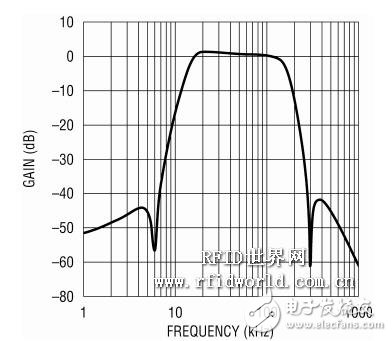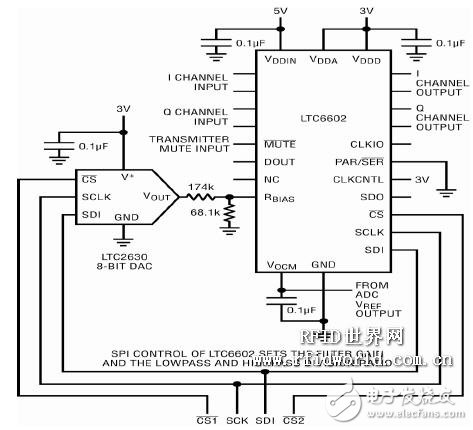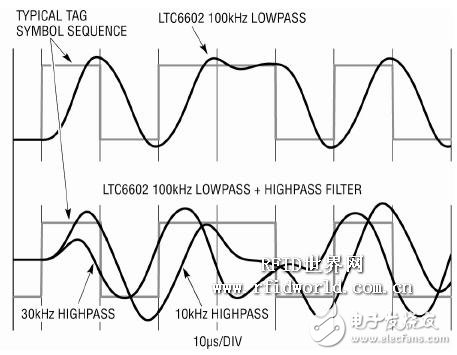Radio Frequency Identification (RFID) is an automatic ID technology that recognizes any object that contains a coded volume label. The UHF RFID system consists of a reader (or interrogator) that modulates an RF signal in the 860MHz to 960MHz frequency range and sends information to the tag. In general, the tag is passive and it receives all the energy needed to operate from a reader that transmits a continuous wave (CW) RF signal. The tag responds by modulating the reflection coefficient of its antenna, thereby backscattering the information signal into the reader.
The volume signal detection needs to measure the time interval between signal transitions (the time interval representing the data "1" symbol is longer than the symbol representing the data "0"). The reader initiates the process of providing inventory information by sending a signal indicating the backscatter data rate and encoding of the label.
RFID readers can operate in a noisy RF environment where many readers are in close proximity. The three operating modes of single interrogator, multi-interrogator and dense interrogator determine the spectral limits of the reader and tag signals. The software programmability of the receiver allows it to achieve an optimal balance between reliable multi-volume detection and high data throughput.
The programmable reader contains a high linearity direct conversion I and Q demodulator, several low noise amplifiers, a dual channel fundamental frequency filter with variable gain and bandwidth, and a dual channel analog-to-digital converter (ADC) ). The dual channel, matched and programmable bandpass filter LTC6602 optimizes high performance RFID readers.
Dual channel bandpass filterThe LTC6602 has two identical filter channels with matched gain control and frequency controlled low pass and high pass networks. The phase shift through each channel is matched to ±1 degree. The internal or external frequency frequency positions the passband of the filter to the desired spectrum.
The low pass and high pass corner frequencies and filter bandwidth are set by the scale ratio of the frequency frequencies. The low-pass scale ratio options are 100, 300, and 600, while the Qualcomm scale ratios are 1000, 2000, and 6000. Figure 1 shows a typical filter response with a 90MHz internal frequency with high-pass and low-pass scaling ratios set to 6000 and 600. The fourth-order elliptical cut-off stopband response helps eliminate out-of-band noise. Controlling the fundamental frequency bandwidth allows the RFID receiver to define its operating mode in the process of adapting the RFID receiver to the working environment.

Figure 2 shows a simple and LTC6602-based filter circuit that uses SPI serial control to vary the gain and bandwidth of the filter to accommodate a complex set of data rates and encodings. (Backscatter links range from 40kHz to 640kHz, while data rates range from 5kbps to 640kbps.)

To achieve fine resolution positioning of the filter, the internal frequency frequency is set by an 8-bit LTC2630 DAC. The 0V to 3V DAC output range determines the frequency between 40MHz and 100MHz (234.4kHz per bit). The low pass and high pass scales are set by the serial SPI control of the LTC6602.
The high-pass filter has a cutoff range of 6.7kHz to 100kHz, while the lowpass filter has a 66.7kHz to 1MHz. The optimal filter bandwidth setting can be adjusted by a software algorithm and is a function of data frequency, data rate and encoding. The filter bandwidth must be narrow enough to maximize the dynamic range of the ADC input while being wide enough to protect the signal transition and pulse width (the correct filter settings ensure reliable DSP tag signal detection).
Figure 3 shows an example of the time domain response of a filter to a typical sequence of symbol symbols (a "short" pulse interval followed by a "long" pulse interval). The low-pass cutoff frequency is set equal to the reciprocal of the shortest time interval (fCUTOFF = 1/10μs = 100kHz). If the low-pass cutoff frequency is lower, the signal transitions and time intervals will be distorted unrecognized. The setting of the high-pass cutoff frequency is more qualitative than specific.
The high-pass cutoff frequency must be lower than the reciprocal of the longest time interval (high-pass fCUTOFF < 1/20μs for the example shown) and should be as high as possible to reduce the receiver's low frequency noise (baseband amplifier and downconverting phase) With amplitude noise). The lower half of Figure 3 shows the overall response of the filter (low pass plus high pass filter).
Comparing the filter outputs with 10 kHz and 30 kHz high-pass settings, the signal transition and time interval of the 10 kHz output is sufficient for detecting symbol sequences (in the RFID environment, the noise will overlap on the output signal). In general, increasing low-pass fCUTOFF and/or lowering high-pass fCUTOFF means “increasing†the “quality†of signal transitions and time intervals at the expense of increased filter output noise.

The LTC6602 dual channel bandpass filter is a programmable fundamental frequency filter for high performance UHF RFID readers. The LTC6602 can be used under software control to operate at high data rates in a single interrogator physical setup, or to achieve optimal label signal detection when working with multiple interrogators or dense interrogator physical settings. The LTC6602 is a very compact IC in a 4mm x 4mm QFN package and can be programmed via parallel or serial control.
Railway insulator,Insulator fittings,Epoxy fiberglass rod,Composite insulator
TAIZHOU HUADONG INSULATED MATERIAL CO.,LTD , https://www.thim-insulator.com
